Key Takeaways from the Gallup State of the American Workplace Study
As we’ve done in the past for Gallup’s State of the American Manager, Deloitte’s Study of Millennials, and others, we’ve pulled out some of the essential takeaways you should know for your teams and companies.
Key Takeaways from the Gallup State of the American Workplace Study
[Ed Note: Our followup to last week’s post on why you should promote from within, has been postponed 1 week. We wanted to get you these takeaways right away.]
The hard thing about soft skills is how difficult and imprecise they can be to measure. Fortunately, Gallup has been surveying managers and employees for decades. They’ve got it down to a science, and they annually report on those findings.
The State of the American Workplace represents over 31 million response from 195,600 employees over the last 2 years. Here’s some of the most interesting takeaways we found in reviewing it.
Engagement is still terrible.
Gallup has been measuring engagement consistently since 2000, and unfortunately the numbers have rarely changed. As the report put it: “Only one-third of U.S. employees are engaged in their work and workplace. And only about one in five say their performance is managed in a way that motivates them to do outstanding work.”
This chart paints the stark picture:
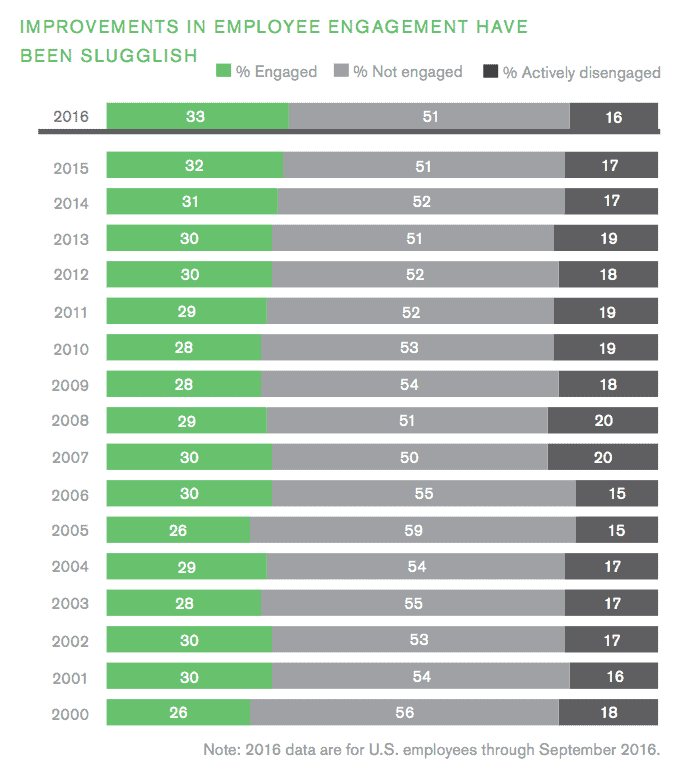
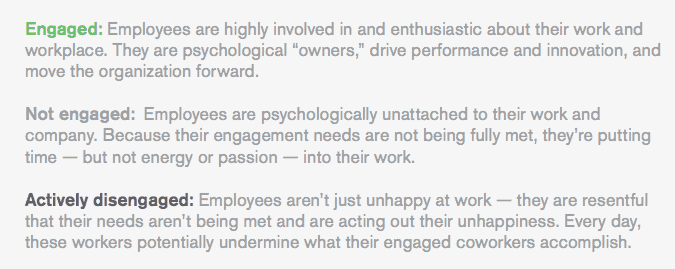
The trend is slightly up from the Great Recession, but when 2 out of 3 people are still mailing it in, or are fully disengaged at work, there’s nothing to be celebrating.
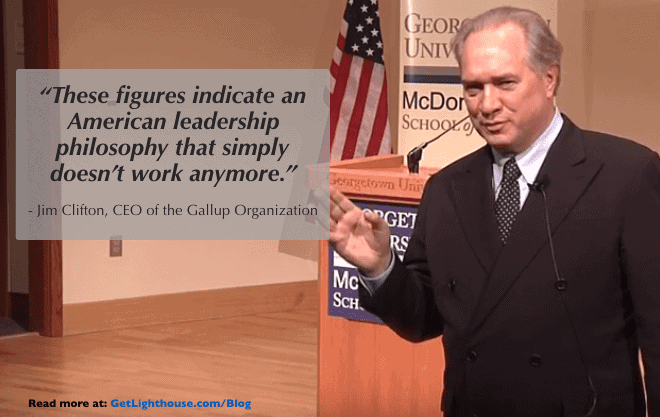
An Indictment of American Leadership styles
There are many causes of poor employee engagement, and the majority of them trace back to leadership actions (and inaction). In particular, Gallup found a few results that are disappointingly low:
- 22% of employees strongly agree the leadership of their organization has a clear direction for the organization.
- 15% of employees strongly agree the leadership of their organization makes them enthusiastic about the future.
- 13% of employees strongly agree the leadership of their organization communicates effectively with the rest of the organization.
The fact that they’re all poor makes sense. Without strong communication, it’s not surprising a path for the organization isn’t clear, which then makes enthusiasm for the future unlikely.
As we know from a past study from Harris poll, most managers are afraid to communicate with their teams:
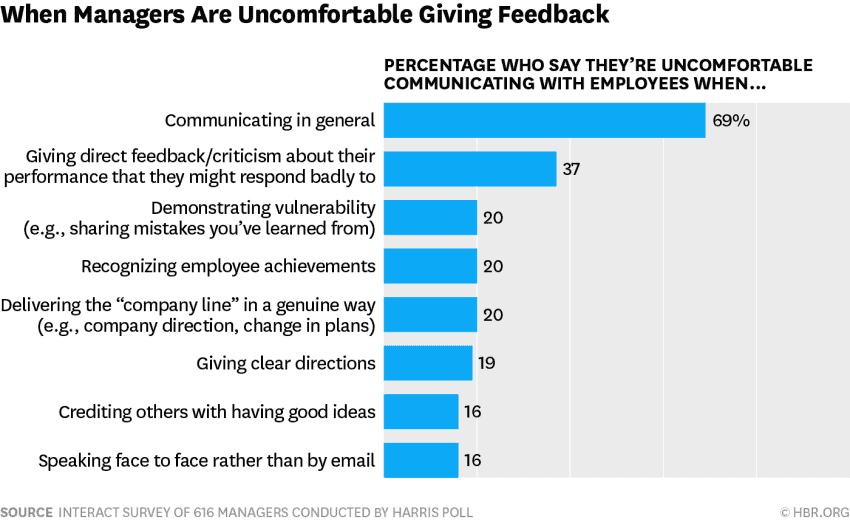
Meanwhile, a study reported in the Harvard Business Review found the most basic form of communication, one on ones, can have a massive impact on the opinion of leadership, and the degree of employee engagement:
“When a manager doesn’t meet with employees one-on-one at all…Employees are four times as likely to be disengaged…and are two times as likely to view leadership more unfavorably compared to those who meet with their managers regularly.”
Suddenly, it’s not so surprising that engagement is so poor. As Gallup’s CEO, Jim Clifton, writes, companies need to take their medicine:
“Organizations have nowhere to hide. They have to adapt to the needs of the modern workforce, or they will find themselves struggling to attract and keep great employees and therefore customers.”
This message is the centerpiece of Gallup’s report.
Many employees are ready to move on.
If you’re worried about retention at your company, or already have a problem, the results of the State of the American Workplace are not encouraging. With the strengthening economy, employees are thinking more and more like free agents. They’re thinking about their next move:
“A record 47% of the workforce says now is a good time to find a quality job, and more than half of employees (51%) are actively looking for new jobs or watching for openings.”
This is even greater than the recent numbers from Deloitte’s study of Millennials:
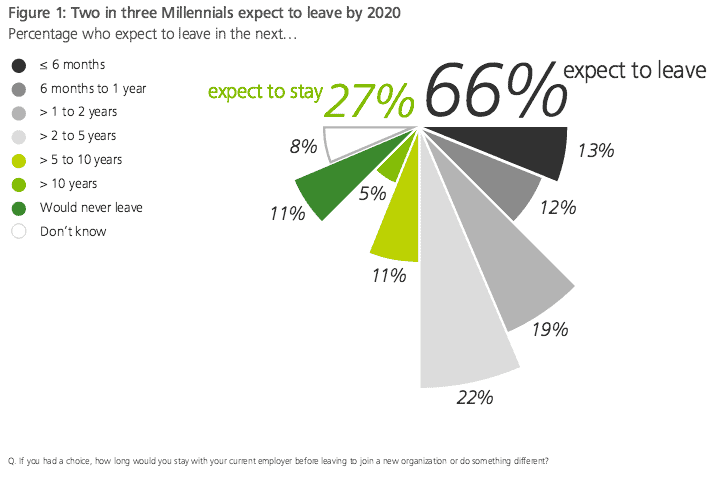
It’s also a big change from just a few years ago:
The stronger economy, combined with a lack of change in the average American workplace’s quality of environment for too long seems to have many thinking the “grass is greener” at other workplaces:
“Currently, 63% believe it is “very likely” or “somewhat likely” that they would find a job as good as the one they have, up from 42% who said the same in 2010.”
If you’re worried someone on your team is looking for another job, Gallup’s data gives you many reasons to think they probably are. Remember: You have to act now. By the time they have an offer it’s too late.
Growth & development is still at the top of employees’ wish lists
We’ve talked about the importance of growing your people many times before on the Lighthouse blog, and Gallup’s State of the American Workplace only adds to this overwhelming pile of evidence:
1) “68% of employees believe they are overqualified for their current job”
This is likely an artifact of the Great Recession, where people often took jobs they were overqualified for, because they really needed a job. However, it’s also a case of people being in the same job for too long.
When you have the same job and responsibilities for too long, it’s easy to grow bored, and feel overqualified. All to often, this happens on teams where managers take their team for granted, and don’t realize just how long some people have been doing exactly the same thing.
Even if you can’t promote your people, there are a lot of things you can do to help them grow. You can learn a variety of approaches to doing so in our post on “How to Grow Your People When You Can’t Promote them” here.
2) Growth is important to everyone, but especially Millennials.
As you can see in the chart below, Millennials are very concerned with the trajectory of their careers.
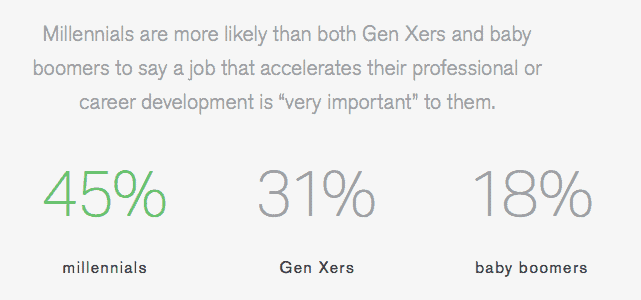
Are you helping them grow? Are you talking about their growth path? If not, we can see clearly that they’re probably seeking growth opportunities at another company.
3) Goals should be a conversation, not a dictatorship
One of the most disappointing stats is just how few employees feel involved in their goal setting process:
“30% of employees strongly agree that their manager involves them in setting their goals at work.”
Often, the goals set for you are your single best opportunity for growth; your goals will tie directly to potential future raises, recognition, and promotions. A good goal also stretches you, providing much of the growth employees crave. This is likely why then it’s so strongly tied to engagement:
“Those who do strongly agree with [their manager involves them in setting their goals] are 3.6 times more likely than other employees to be engaged. “
If you’re not involved in the process of setting your goals, what are the odds they align with ways you’d like to grow?
As leaders, these goals conversations should be easy. Most employees want to help their company succeed, and with just a few tweaks and a little input, they can feel increased input and strong alignment between what you need and their goals.
The evolving job search process
This time around, Gallup went beyond just engagement. They also expanded to look at why people leave jobs, and what attracts them to their next one.
The reasons people leave jobs is not entirely surprising. It’s things you would expect like:
- Career growth opportunities
- Pay/benefits
- Their manager or management in general
- Company culture
- Job fit
We’ve heard these kinds of concepts before, and so many of them are why people leave managers, not companies. Your manager influences how close your job is to the description you were promised. They are key to your career growth, and are the main representative of your company’s culture, as we love to quote Andy Grove on:
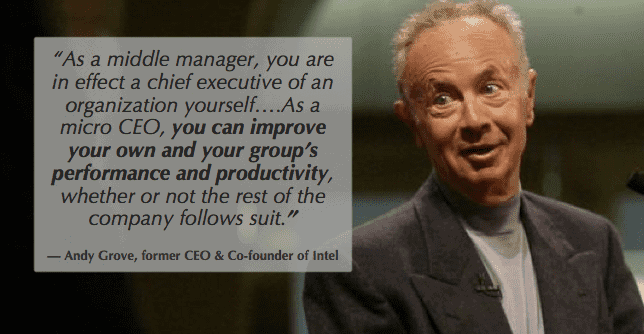
How well are you adapting to the new way people search for jobs?
The world is very different from a generation ago. What used to be THE WAY to find jobs is relegated to the bottom of Gallup’s list, replaced by modern technology:
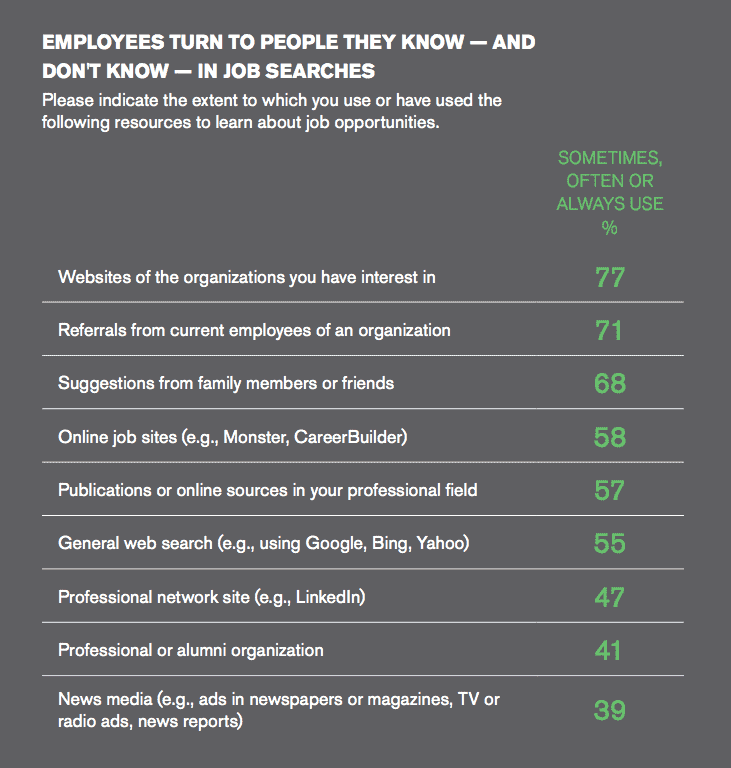
While professional organizations and news media are falling, and internet options rise, the highest yield are surprisingly low tech.
Let’s look at the top 3 the most. 3 out of 4 people are doing all of the following:
- Checking out your company’s website to learn about you: What impression does your site give?
- Talking to current employees at your company: If your engagement scores are low, that’s a lot of people that may actually discourage people from working there.
- Talking to their friends and family: Who is more likely to give you an honest evaluation, or a strong sell if they’re happy?
If you have trouble recruiting, ask yourself if how you treat your current employees might be a major part of why.
Learn more in Gallup’s State of the American Workplace Report…
There’s a lot more in this massive, 214 page study, like an in depth look at perks employees want most, how performance management is evolving, and Gallup’s 12 Elements survey that are the keys to engagement, so we highly recommend you go check out the full report here.
You can check out the full report here: http://www.gallup.com/reports/199961/state-american-workplace-report-2017.aspx
Also, Lighthouse friend, Mark Crowley has written up his own insights you can read here.
You can also read our takeaways from Gallup’s State of the American Manager report from 2014 here, and from Gallup’s book on what great managers do differently here.
What was the most interesting insight for you in Gallup’s latest research? Leave a comment with your thoughts.

